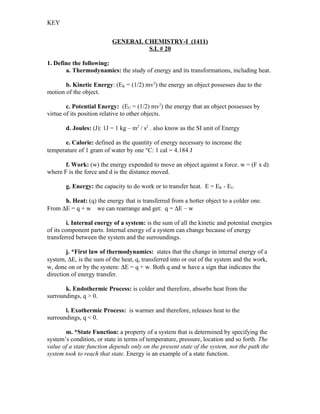
#20 Key
- 1. KEY GENERAL CHEMISTRY-I (1411) S.I. # 20 1. Define the following: a. Thermodynamics: the study of energy and its transformations, including heat. b. Kinetic Energy: (EK = (1/2) mv2) the energy an object possesses due to the motion of the object. c. Potential Energy: (EU = (1/2) mv2) the energy that an object possesses by virtue of its position relative to other objects. d. Joules: (J): 1J = 1 kg – m2 / s2 . also know as the SI unit of Energy e. Calorie: defined as the quantity of energy necessary to increase the temperature of 1 gram of water by one °C: 1 cal = 4.184 J f. Work: (w) the energy expended to move an object against a force. w = (F x d) where F is the force and d is the distance moved. g. Energy: the capacity to do work or to transfer heat. E = EK - EU h. Heat: (q) the energy that is transferred from a hotter object to a colder one. From ∆E = q + w we can rearrange and get: q = ∆E – w i. Internal energy of a system: is the sum of all the kinetic and potential energies of its component parts. Internal energy of a system can change because of energy transferred between the system and the surroundings. j. *First law of thermodynamics: states that the change in internal energy of a system, ∆E, is the sum of the heat, q, transferred into or out of the system and the work, w, done on or by the system: ∆E = q + w. Both q and w have a sign that indicates the direction of energy transfer. k. Endothermic Process: is colder and therefore, absorbs heat from the surroundings, q > 0. l. Exothermic Process: is warmer and therefore, releases heat to the surroundings, q < 0. m. *State Function: a property of a system that is determined by specifying the system’s condition, or state in terms of temperature, pressure, location and so forth. The value of a state function depends only on the present state of the system, not the path the system took to reach that state. Energy is an example of a state function.
- 2. KEY 2. Suppose you toss a tennis ball upward. a) Does the kinetic energy of the ball increase or decrease s it moves higher? b) What happens to the potential energy of the ball as it moves higher? c) If the same amount of energy were imparted to a ball the same size as a tennis ball, but twice the mass, how high would it go in comparison to the tennis ball? An object can possess energy by virtue of its motion or position. Kinetic energy, the energy of motion, depends on the mass of the object and its velocity. Potential energy, stored energy, depends on the position of the object relative to the body with which it interacts. 3. a) Calculate the kinetic energy in joules of a 45-g golf ball moving at 61 m/s. b) convert this energy to calories. c) What happens to this energy when the ball lands in a sand trap? a. 1 J = (1 kJ) (m2/s2) and EK = ½ mv2 EK = ½ (45g) (1kg / 1000 g) (61 m2 / 1 s2) = 84 kg m2 / s2 = 84 J b. (83.72 J) (1 cal / 4.184 J) = 20 cal c. as the ball hits the sand, its speed and the kinetic energy drops to zero. 4) a) What is the kinetic energy in joules of a 950 lb motorcycle moving at 68 mph? b) By what factor will the kinetic energy change if the speed of the motorcycle is decreased to 34 mph? c) Where does the kinetic energy of the motorcycle go when the rider brakes to a stop? a. (950 lb) (1kg / 2.205 lb) = 431 kg = m and (68 mi /hr) (1.6093 km/1mi)(1000m/1km)(1hr/60min)(1min/60sec)=30 m/s = v so EK = ½ mv2 = ½ (431kg)(30m/s)2 = 2.0x105 J b. EK is proportional to v2, so if speed decreases by a factor of 2, kinetic energy decreases by a factor of 4 c. Brakes stop a moving vehicle, so the kinetic energy of the motorcycle is primarily transferred to friction between brakes and wheels, and somewhat to deformation of the tire and friction between the tire and road. 5) Calculate ∆E, and determine whether the process is endothermic or exothermic for a) a system that absorbs 85 kJ of heat from its surroundings while doing 29 kJ of work on the surroundings. b) q = 1.50 kJ and w = -657 J. c) the system releases 57.5 kJ of heat while doing 13.5 kJ of work on the surroundings. a. q is positive b/c the system absorbs heat and w is negative b/c the system does work. ∆E = 85kJ – 29kJ = 56 kJ. The process is endothermic b. ∆E = 1.50 kJ – 657 J 1.50 kJ – 0.657 kJ = 0.84 kJ = Endothermic c. q is negative b/c the system releases heat, and w is negative b/c the system does work. ∆E = -57.5 kJ – 13.5 kJ = -71.0 kJ = Exothermic